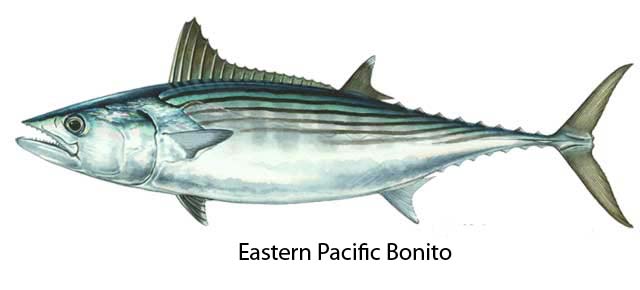
EASTERN PACIFIC BONITO

Sarda chilesis lineolata
English: Eastern Pacific Bonito, Pacific Bonito, Bonita
Spanish: Bonito Oriental Sureno, Bonito del Pacifico Oriental
The Eastern Pacific Bonito is one of the rarest members of the Scobridas or Tuna, Bonito and Mackerel found in Mexican waters.
The Eastern Pacific Bonito is characterized by its “tuna-like” appearance, dark blue-gray back (darker on the head), silver flanks and belly, and a series of 5 to 6 oblique stripes running along its upper back.
The dorsal fin of this fish species is dark, although the second dorsal fin has a white tip. The anal and pelvic fins are white. The caudal and pectoral fins are gray. The tail base is composed of two keels separated by a third larger keel. There are no spots between the pelvic and pectoral fins.
The Eastern Pacific Bonito might be confused with the Black Skipjack, Eurhynnus lineatus (which has 5 to 6 horizontal stripes along its upper sides and distinguishing black spots); the Skipjack Tuna, Katsuwonus pelamis (series of 4 to 6 horizontal diagonal stripes along its upper sides and no spots); and the Striped Bonito, Sarda orientals (8 to 11 broken horizontal stripes along its side, with no spots).
The Eastern Pacific Bonito is a coastal pelagic schooling species that is found near off shore reefs.
It is only found all along the Pacific side of the Baja California peninsula, and along the eastern side of Baja California only as far north as La Paz.. It is normally found in the first 300 feet of the water column, and is reported to reach a length of 24 inches and 22 pounds. It is normally an incidental catch on live sardinas.
It responds to rapidly trolled feathers, or hootchies, or off the bottom with chrome yo-yo iron.
For it size it puts up a horrific fight. The Eastern Pacific Bonito is viewed by locals as a valued food substance utilized as a component of machaca.